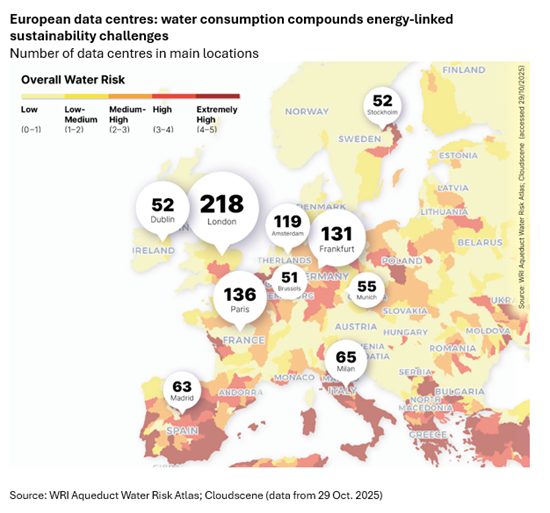Announcements
Drinks

European data centres: water consumption compounds energy-linked sustainability challenges
By Stefan Ritzka, Scope ESG Analysis
More intense regulatory scrutiny over energy and water usage, especially in regions facing environmental stress, is nonetheless aiming to ensure a shift toward more sustainable operational models, most visibly in the European Commission’s energy efficiency directive.
New data centres in Europe will need to demonstrate greater integration of environmental considerations into project planning and high-technology cooling options to mitigate regulatory and reputational risks enhancing long-term value creation.
The number of data centres across the Europe has tripled since 2010, reaching approximately 2,500 facilities by 2024, according to consultancy Cloudscene.
This is a demonstration of the facilities increasingly crucial role as the digital infrastructure underpinning today’s economy but is equally a measure of the significant sustainability challenges they represent through their high energy consumption and substantial water usage.

Energy challenge from data-centre boom is well documented…
The energy component is well known, hence the rush by some data centre owners in the US to build their own power supplies reflecting the rapid growth in the sector. In Europe, data centres in consumed power equivalent to around 10 GW in 2024 – roughly the amount of electricity that a medium-sized country like Austria or Belgium consumes in the same timeframe.
This figure is expected to sharply increase to around 35 GW by 2030, which, if the predicted growth trend remains on track, will result in the sector’s annual electricity consumption across the continent reaching over 150 TWh by the end of the decade, according to McKinsey.
… But water demand is emerging as important environmental concern
A midsized data centre may require up to 420 million litres of water a year – equivalent to the water usage of around a thousand homes – to meet its cooling needs which are equivalent to 20%-40% of its total energy footprint, according to the Environmental and Energy Study Institute. Water-intensive cooling systems are needed to regulate internal temperatures and ensure optimal server performance.
While most of the energy currently consumed by data centres is from renewable resources, according to the European Data Centre Association, data centres are increasing their freshwater consumption to meet their demand.
This presents a particular problem in Europe since that water is often scarce where sources of renewable energy are plentiful such as in Spain and parts of Italy. Nevertheless, the growing demand for cloud services, edge computing, and low-latency connectivity continues to drive data centre development near densely populated urban hubs where water demand is high already.
This demand creates a tension between economic and digital transformation goals and environmental leadership – particularly in drought-risk cities like Athens, Madrid and Milan.
Considering the technological and economic benefits that the presence of data centres can provide coupled with its environmental challenges, countries such as France (through the DGEC) and the Netherlands (Omgevingswet) have introduced energy and water-use reporting requirements actively encouraging more sustainable infrastructure choices.
The expansion of artificial intelligence and the digital economy at large will continue to encourage the continued growth of data centres across Europe, offering strong investment opportunities for countries with the best infrastructure but constrained by growing scrutiny of the sustainability of the sector.
Related research:
Climate-change risk framework: introducing issuer-specific Key Climate Risk Indicators (October 2025)
Spain’s renewable energy push risks running into reliability, pricing, investment obstacles (October 2025)
Technological change, regulation emerge as credit risks amid the expansion of data centres in Europe (September 2025)





